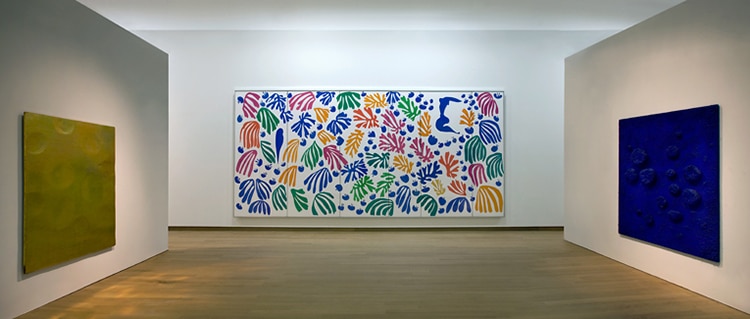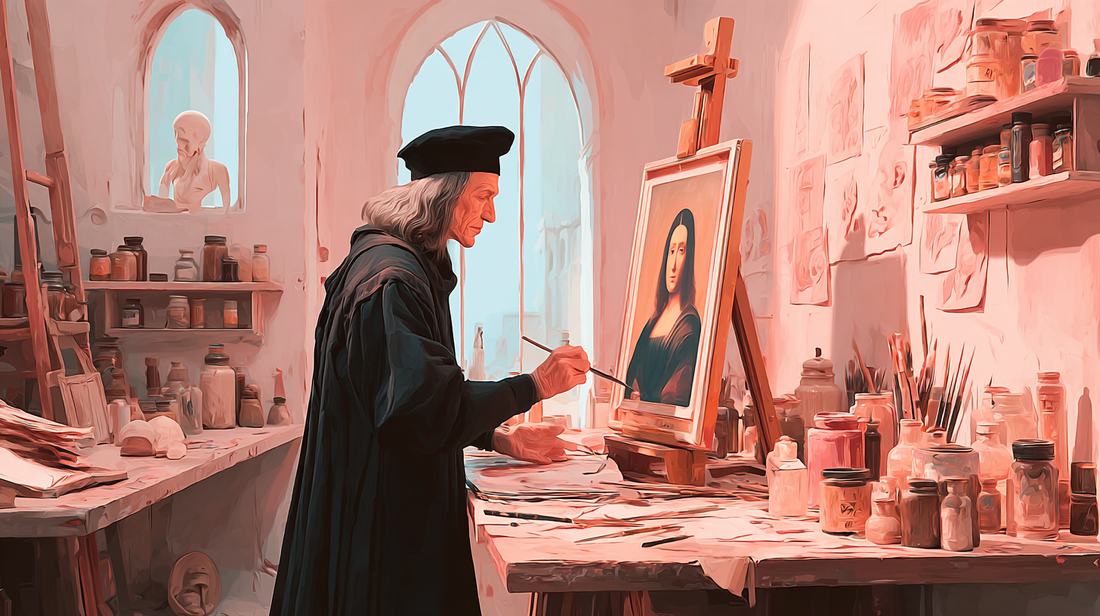Art has always shaped the way we see the world. From Renaissance masters to modern innovators, some of history’s greatest painters have created works that continue to inspire and influence culture today. In this guide, we’ll explore the most famous male painters in history, from Leonardo da Vinci to Van Gogh, Monet, and Picasso and celebrate the masterpieces that made them timeless.
1. Leonardo da Vinci (1452–1519): The Renaissance Polymath
Leonardo da Vinci, often hailed as the epitome of a Renaissance man, was not only a painter but also a scientist, inventor, and visionary. Born in Vinci, Italy, in 1452, da Vinci's artistic brilliance is exemplified by the timeless beauty of the Mona Lisa and the profound symbolism of The Last Supper.
His meticulous attention to detail, use of light and shadow, and innovative techniques make him an unparalleled master of art. Leonardo da Vinci's legacy extends beyond his paintings to his notebooks filled with scientific observations and ingenious inventions, showcasing the breadth of his genius.
2. Vincent van Gogh (1853–1890): The Starry Night Dreamer
Vincent van Gogh, a Dutch Post-Impressionist painter, gifted the world with emotionally charged, vividly expressive works. Despite battling poverty, isolation, and severe mental health struggles, his passion for painting never wavered. Masterpieces like Starry Night (1889), Sunflowers (1888), and The Bedroom (1889) reflect both his inner turmoil and his awe at the beauty of the world around him.
His bold colours and swirling brushstrokes created a style that was deeply personal and instantly recognisable. Van Gogh’s tragic life, selling only a handful of paintings before his death in 1890, adds poignancy to his work. Today, he’s not only remembered as a genius but also as someone who used art to cope with his struggles.
We started Kiki’s Club because we believe in that same healing power of creativity. Our paint by numbers kits were created to give people a calming, mindful way to reduce stress and reconnect with themselves, echoing the comfort and meaning that Van Gogh found in his art.
3. Pablo Picasso (1881–1973): The Cubist Visionary
Pablo Picasso, the Spanish painter and sculptor, co-founded the Cubist movement and reshaped the way we perceive reality. His works like Les Demoiselles d’Avignon (1907) broke away from centuries of tradition, while Guernica (1937) became one of the most powerful anti-war paintings ever created. With its fragmented figures and stark palette, Guernica condemned the bombing of a Basque town during the Spanish Civil War and became a universal symbol against violence and oppression. Its influence on modern art and even political activism is impossible to overstate.
But Picasso’s legacy isn’t only about innovation. His personal life, especially his relationships with women, has sparked widespread criticism. Many of his muses and partners, including Dora Maar and Françoise Gilot, described him as manipulative, controlling, and even abusive. While his genius shaped the 20th century, his behaviour reminds us that great art can come from deeply flawed individuals.
Picasso’s story is a reminder to celebrate artistic breakthroughs while also questioning the myths that often surround “great men” in history.

4. Claude Monet (1840–1926): The Impressionist Maestro
Claude Monet, a French Impressionist painter, embraced the fleeting beauty of nature, capturing its essence through his iconic series paintings. Born in 1840, Monet's "Water Lilies," "Haystacks," and "Rouen Cathedral" showcase his mastery of capturing light and atmosphere.
His innovative approach to art, characterized by loose brushstrokes and a focus on the effects of light, laid the foundation for the Impressionist movement. Monet's dedication to his craft and his ability to translate the beauty of the natural world onto canvas have solidified his place in art history.
5. Rembrandt van Rijn (1606–1669): The Master of Light and Shadow
Rembrandt van Rijn, a Dutch Golden Age painter, is celebrated for his extraordinary use of light and shadow, creating evocative and emotionally charged portraits. Rembrandt's The Night Watch is a testament to his skill in capturing the vibrancy of a scene and the nuanced expressions of its subjects.
His self-portraits are a poignant exploration of his own humanity and the passage of time. Rembrandt's ability to convey deep emotion and his technical prowess in creating atmospheric scenes make him a luminary in the history of art.
6. Diego Velázquez (1599–1660): The Court Painter
Diego Velázquez, a Spanish Baroque painter, rose to prominence as the court painter to King Philip IV. Born in Seville in 1599, he moved to Madrid in his early twenties and quickly became the most important artist in Spain.
In 1656, at the age of 57, Velázquez painted his most famous masterpiece, Las Meninas. At first glance, it appears to be a portrait of the young Infanta Margarita surrounded by her ladies-in-waiting, a dwarf, and a dog. But the painting is far more complex: Velázquez also depicts himself at work on a canvas, while in the background, a mirror reflects the images of King Philip IV and Queen Mariana, suggesting that the royal couple are the true sitters. This layered composition blurs the boundaries between artist, subject, and viewer, making Las Meninas one of the most innovative paintings in Western art.
Velázquez’s ability to infuse humanity into his royal subjects, portraying them not as distant symbols of power but as individuals with presence and personality — was groundbreaking. His brushwork, naturalistic light, and daring use of perspective influenced countless later artists, including Goya, Manet, and Picasso. Today, Las Meninas remains a touchstone for discussions about representation, reality, and the role of the artist, cementing Velázquez’s status as one of the great masters of art history.

7. Francisco Goya (1746–1828): The Chronicler of Human Struggles
Francisco Goya, a Spanish Romantic painter, delved into the darker aspects of human nature, producing poignant and powerful works that transcend time. Goya's most famous painting, The Third of May 1808 depicts the horrors of war, illustrating the courage of the Spanish people against the French occupation.
The Black Paintings, created in his later years, offer a haunting exploration of human folly and suffering. Goya's unflinching portrayal of the human condition has left an enduring impact on the art world.
8. Henri Matisse (1869-1954): The Colorful Visionary
Henri Matisse, the French artist often called the leader of Fauvism, transformed the 20th-century art scene with his fearless use of colour and form. Works like The Dance (1910) and The Red Studio (1911) radiate movement, vitality, and freedom. His bold palette, often clashing, unapologetically bright, and emotionally driven, shocked critics at first but soon established him as one of modern art’s giants.
But behind the vibrancy of his paintings was a life of contradictions. Matisse trained as a lawyer before turning to art after a bout of illness left him bedridden, a turning point that sparked his lifelong belief in art as a source of healing and joy. Later in life, after major surgery left him largely confined to bed and wheelchair-bound, he reinvented his practice through his famous “cut-outs” using scissors, paper, and colour to create monumental, joyful works despite physical limitations.
Matisse’s story is not just about bold colours but also resilience, reinvention, and finding light in the face of pain. His ability to create joy through art, even in the darkest of personal moments, is why his work continues to resonate across generations.

9. William Morris (1834-1896): The Artist and Craftsman
William Morris, a British artist and designer, played a pivotal role in the Arts and Crafts Movement. Born in 1834, Morris believed in the beauty of handmade craftsmanship and the integration of art into everyday life.
His intricate wallpaper and textile designs, including the iconic Strawberry Thief, showcase his commitment to reviving traditional crafts in the face of industrialization. Morris's influence extended beyond painting, emphasizing the importance of art in enriching the human experience.
The Legacy of the Masters
From Leonardo da Vinci’s Renaissance genius to Van Gogh’s emotional intensity, from Picasso’s radical reinventions to Monet’s shimmering landscapes, the lives and works of these painters shaped the way we see art and ourselves. Each of them pushed boundaries, broke conventions, and left behind masterpieces that continue to resonate across centuries.
But their stories also remind us that artists are human: brilliant yet flawed, celebrated yet often struggling with personal demons. By looking honestly at both their triumphs and their failings, we gain a richer, more authentic understanding of art history.
At Kiki’s Club, we believe creativity shouldn’t be reserved for the masters. Paint by numbers makes art accessible to everyone by giving you a way to slow down, manage stress, and experience the joy of creating something beautiful with your own hands. Just as these painters left their mark on history, you can leave your own brushstrokes on the canvas and find meaning in the process.
Art is timeless, but so is the human need to create.
Read More: Celebrating Famous Female Painters Through History and Famous Paintings & Their Hidden Meanings

